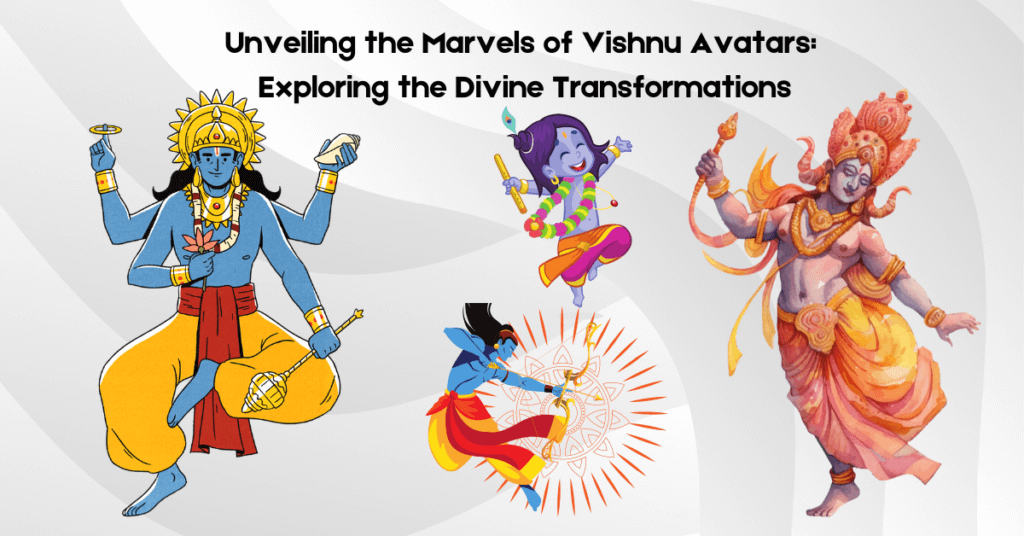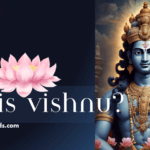Discover the Sacred Incarnations of Vishnu Avatar
Vishnu Avatar. Today, we’re discussing one of the fascinating part of the Hinduism world. In this post we’ll read about one of history’s most important deities—Vishnu! Vishnu, along with Brahma and Shiva, is the potent trinity at the centre of Hindu religious practise.
Let us now discuss Vishnu’s participation in this cosmic movement. He’s the ultimate superhero, the protector and preserver of everything. Vishnu descends from his holy home in one of his countless incarnations to restore justice whenever chaos or evil threatens to take over the universe.
What a supernatural presence!
These Vishnu incarnations are referred to as Vishnu avatars. It’s as if he’s changing into fresh apparel to tackle the challenges that life throws at him. Indeed, Hindu texts identify ten such avatars, each with their unique form and function.
Which god has the most avatar?
During the Satya Yuga, when gods walked among humans, they were thought to have roamed the globe. Dasavatara is the collective name for these ten avatars.
When someone faces a challenging challenge, Vishnu sends down the right avatar to confront it. It’s almost like a tailored response to the scenario at hand. Isn’t it incredible?
Why did Vishnu take 10 avatars?
The great thing about these avatars is that they are each tied to a certain point in history when they were most needed. Some people call it the cosmic cycle or the Time-Spirit. Consider Matsya, the very first Vishnu avatar. He made his grand entrance long before the eighth incarnation, Balarama. However, there is an intriguing twist: according to certain current legends, Balarama is the Lord Buddha himself. What a surprising plot twist!
The ultimate objective of these Vishnu avatars, regardless of time or location, is to restore dharma. Dharma, my friends, is the teaching of the Hindu texts on the path of justice and universal ideals. As you can see, these avatars are more than just mythological beings.
Which avatar of Vishnu is more powerful?
Vishnu, the great preserver and guardian of Hinduism, and his magnificent incarnations. When things go out of hand in the world, they bring with them hope, righteousness, and a feeling of order. Hinduism surely understands how to keep cosmic balance!
Keep an open mind, keep exploring, and enjoy the rich tapestry of information available on our world. Take care till next time, and keep searching for the truth!

What are the 10 avatar of Vishnu?
Matsya (Fisherman avatar)
According to the cosmic cycle, Matsya descended in the distant past to preserve life amid a massive flood. In the form of a fish, Vishnu guided Manu, the creator of humanity, and saved him as well as numerous animal species. This avatar signifies protection, survival, and the ability to adapt to adversity.
Kurma (Tortoise Vishnu Avatar)
Kurma emerged as a massive tortoise to support Mount Mandara during the legendary “Churning of the Ocean,” acting as a pivot for the churning process. This avatar indicates stability, patience, and a readiness to face adversity in pursuit of a greater goal.
Varaha (Boar Vishnu Avatar)
Varaha appeared as a big boar to take the planet out of the cosmic ocean and save it. This avatar represents perseverance, strength, and the ability to overcome obstacles in order to restore balance and order.

Narasimha ( Lion Avatar)
In the Narasimha tale, Vishnu incarnated as a half-man, half-lion monster to battle the demon ruler Hiranyakashipu, who had acquired invincibility owing to a divine gift. This avatar depicts good triumphing over evil, devotee protection, and the preservation of virtue.
Vamana (Dwarf Avatar)
Vamana, the dwarf avatar, emerged to defeat Bali, the powerful demon king with immense power and influence. Vishnu appeared as a small Brahmin seeking alms and, by a great strategy, reclaimed sovereignty of the world, preserving cosmic order and justice.
Parashurama (Warrior Sage Avatar)
The strong warrior sage Parashurama was created to cleanse the ruling elite of injustice and corruption. With an axe in hand, this avatar signifies courage, righteousness, and the restoration of societal harmony.
Rama (Avatar of the Ultimate King)
Rama, a perfect example of purity and virtue, embarked on an epic journey to rescue his wife Sita from the evil king Ravana. In terms of honesty, loyalty, and the triumph of good over evil, Rama is the ideal ruler.

Krishna (Divine Diplomat’s Avatar)
Krishna, a charming and astute diplomat, played a pivotal role in the epic Mahabharata. Krishna guided the Pandavas, the upright heroes, through moral quandaries and provided profound philosophical insights in the Bhagavad Gita. This avatar represents diplomacy, guidance, and the path of commitment.
Balarama (Elder Brother -Vishnu Avatar)
Balarama is the epitome of power and vigor who assisted Krishna in his sacred journey. This avatar denotes safety, support and the brotherly bond.
Kalki(Future avatar)
Kalki is the last avatar who is expected to come at the end of the current age of darkness (Kali Yuga). Kalki will ride a white horse into the world to cleanse it of evil. He will restore righteousness and bring in a new cycle of existence.

In Hindu religious practises, Vishnu, the preserver and protector is immensely essential. He shows divine traits through his avatars and intervenes to restore righteousness in the face of chaos or wickedness.
The stories and allegories of each avatar serve as eternal lessons within Hinduism, reinforcing the path of justice and universal ideals. Vishnu’s miraculous incarnations continue to inspire and guide millions of people, fostering compassion, justice, and spiritual advancement.





